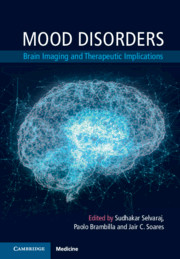Book contents
- Mood Disorders
- Mood Disorders
- Copyright page
- Contents
- Contributors
- Preface
- Section 1 General
- Section 2 Anatomical Studies
- Section 3 Functional and Neurochemical Brain Studies
- Section 4 Novel Approaches in Brain Imaging
- Section 5 Therapeutic Applications of Neuroimaging in Mood Disorders
- Index
- Plate Section (PDF Only)
- References
Section 1 - General
Published online by Cambridge University Press: 12 January 2021
- Mood Disorders
- Mood Disorders
- Copyright page
- Contents
- Contributors
- Preface
- Section 1 General
- Section 2 Anatomical Studies
- Section 3 Functional and Neurochemical Brain Studies
- Section 4 Novel Approaches in Brain Imaging
- Section 5 Therapeutic Applications of Neuroimaging in Mood Disorders
- Index
- Plate Section (PDF Only)
- References
- Type
- Chapter
- Information
- Mood DisordersBrain Imaging and Therapeutic Implications, pp. 1 - 6Publisher: Cambridge University PressPrint publication year: 2021

